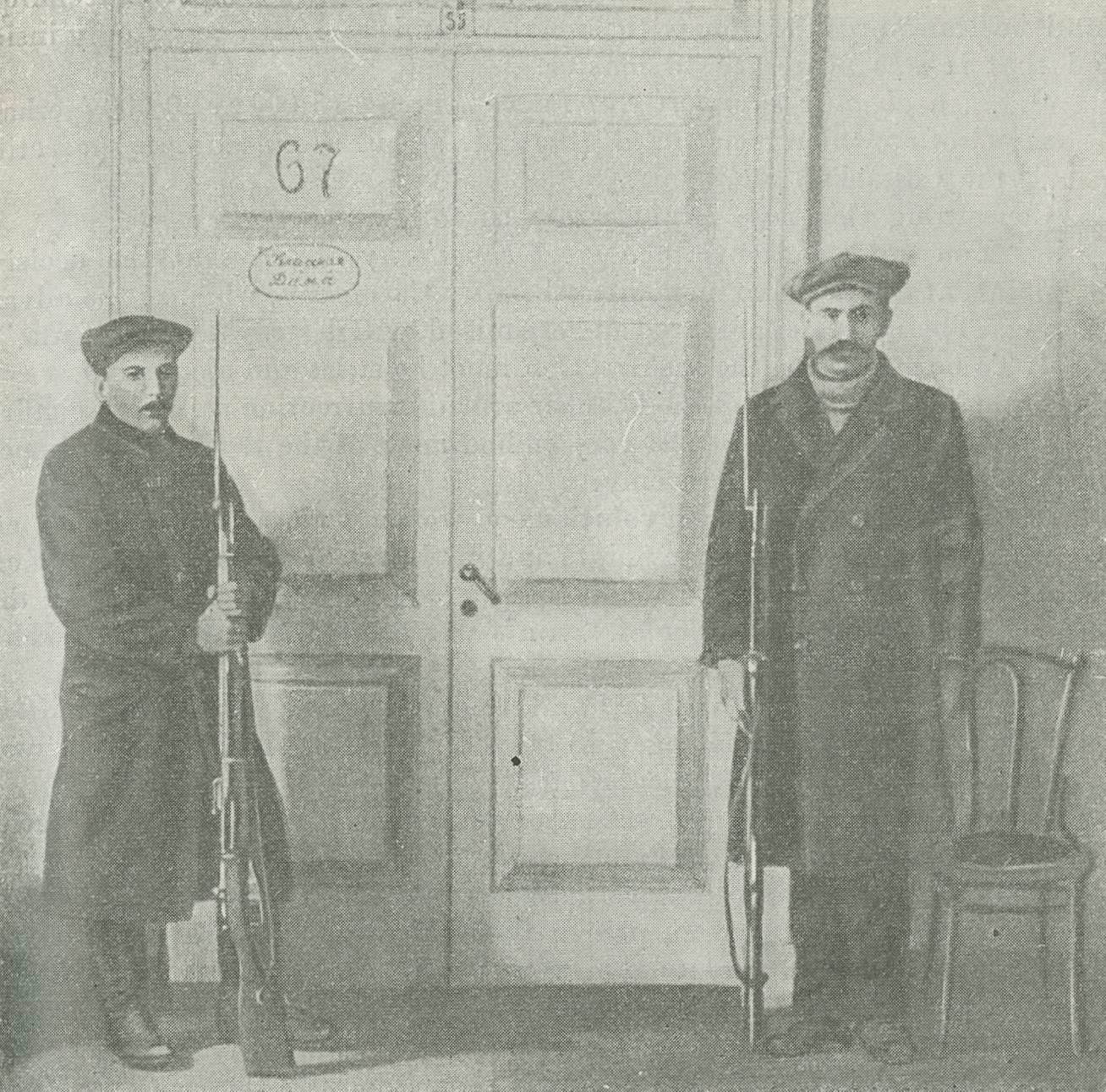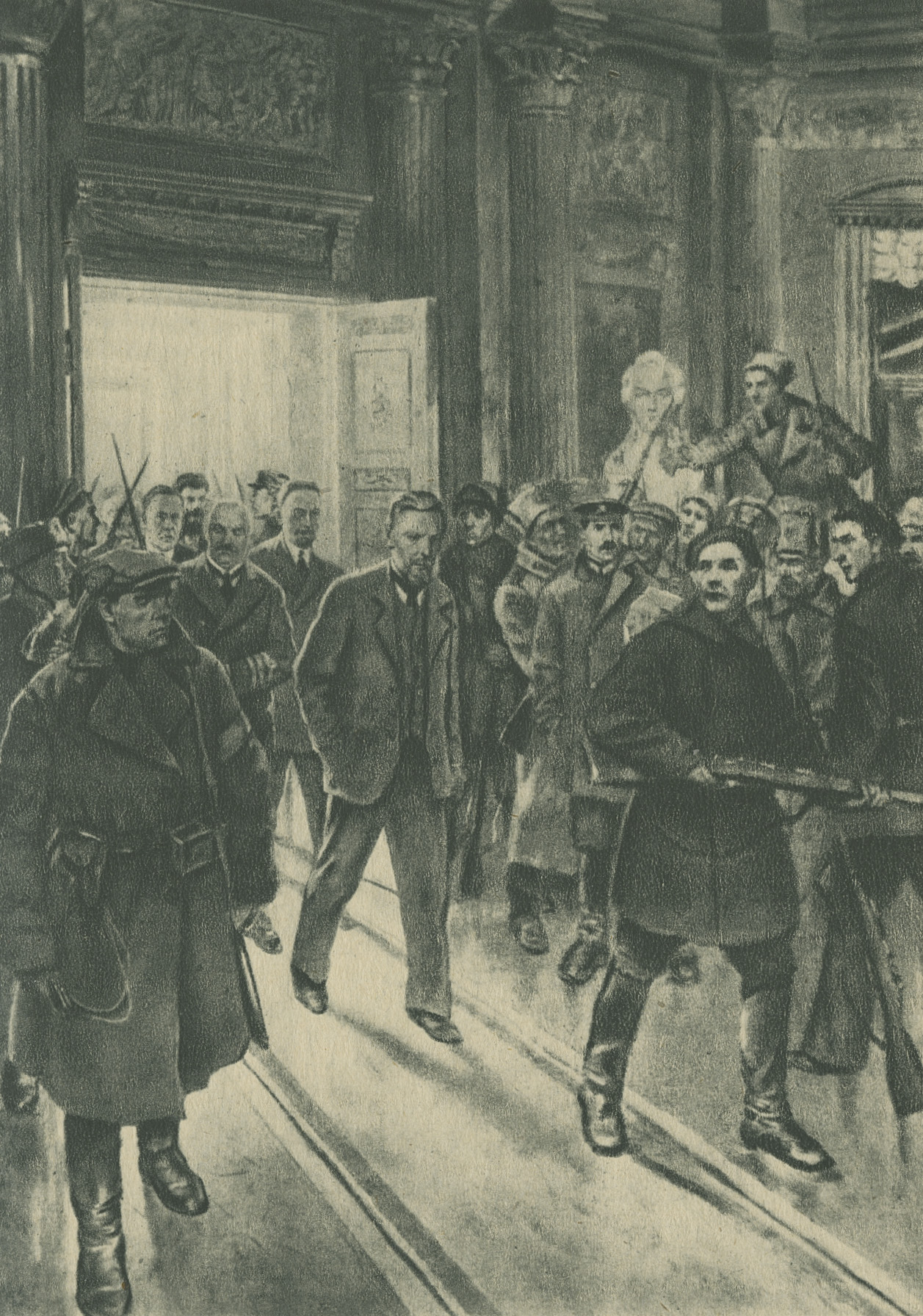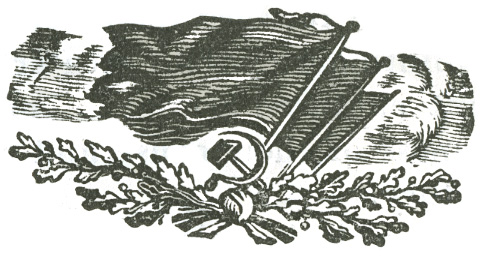
The October insurrection serves as a classical example of the tactics of armed insurrection as elaborated by the founders of scientific Socialism, Marx and Engels, and by their great successor and continuator, Lenin. The October insurrection incorporated the entire experience of the struggle of the world proletariat and was the culmination of the revolutionary path traversed by the Bolshevik Party. The heroic struggle of the Petrograd proletariat once again proved that armed insurrection is a special form of the political struggle and is subject to special laws. It was this tenet of Marxism that was, perhaps, most distorted by the Second International. International Menshevism accused all those who tried to put Marxist revolutionary ideas into practice of being Anarchists; and those who demanded that the special laws of insurrection should be studied, they accused of being Blanquists. Blanqui, the well-known French revolutionary, conceived revolution as a coup d’état, prepared and carried out by a small group of secret conspirators. He argued that a small compact group could, by sudden action, achieve initial successes, which in their turn, would rouse the masses. In this way a revolution could be accomplished.
Marxism, however, has nothing in common with this “conspirator” theory and practice of revolution.
The October proletarian revolution was a brilliant example of the practical application of the Marxian theory of armed insurrection. What were the most important political and tactical lessons taught by the armed insurrection in Petrograd in October 1917?
1. That victory never comes “of its own accord”; it is achieved only by stern, stubborn and organised struggle. However demoralised the enemy forces may be, and however much wavering there may be in his ranks, the enemy must be defeated; the enemy class must be crushed.
This, however, calls for extremely careful preparation.
The Bolshevik Party took advantage of every opportunity to mobilise its forces and to establish the closest possible contact with the provinces. The Central Committee sent its representatives to all conferences, congresses and meetings to inform the Bolshevik delegates about the situation and to arrange with them the distribution of forces. The Bolshevik delegates at the Northern Congress of Soviets were commissioned, on their return, to convey the Party’s instructions to their respective districts. At the Congress of Cities held in Moscow the Bolshevik delegates arranged among themselves the part each region was to play in the forthcoming insurrection. Members of the Central Committee, or its representatives, were sent to the various districts. On the other hand, Party officials from the industrial centres visited the Central Committee. The closest contact was maintained between the centre and the localities. Representatives of the Central Committee, correspondence, the press and the telegraph, were all utilised for the purpose of keeping the leading Party members informed of the maturing events, so that the Party might be fully prepared for action.
An important element of the preparations for the insurrection was the isolation of the compromising parties. In the capital and in the industrial centres this isolation was revealed by the way the Bolsheviks gained control of the Soviets. At Lenin’s suggestion, speakers were sent to the rural districts to explain the Bolsheviks’ policy to the peasants. Soldiers on furlough were put through a short course of training and supplied with Bolshevik literature before proceeding to their homes.
The isolation of the compromising parties facilitated the task of creating a united front of revolutionary proletarians and other working people. The October Socialist Revolution was a people’s revolution in the sense that Marx understood this term. The Bolsheviks succeeded in winning the masses away from the Socialist-Revolutionaries and Mensheviks. Many of the rank-and-file members of the compromising parties deserted their leaders and followed the Bolsheviks. The overwhelming majority of the working people supported the proletariat, headed by the Bolshevik Party. As Lenin wrote:
“We have the support of the majority of the class, the vanguard of the revolution, the vanguard of the people, which is capable of carrying the masses with it. We have the support of the majority of the people. And that is the chief reason for the popular character of the revolution.”[1]
During the October Socialist Revolution the Bolshevik Party displayed exceptional skill in winning over the army. The revolution wrested the army out of the hands of the counter-revolution. The bourgeoisie had the support only of detachments of Whiteguards formed on class lines, such as the cadets, shock troops and officers’ units.
Great attention was paid to the task of demoralising the enemy’s ranks. Bolshevik propagandists permeated the forces of the Provisional Government. The majority of the soldiers serving as auxiliaries in the Officers’ Training Schools were under Bolshevik influence. Bolshevik propagandists were discovered and arrested in the Winter Palace itself, even during the siege.
At Lenin’s suggestion, a Revolutionary Staff was formed under Stalin’s direct leadership, which drew up the plan of operations and distributed the forces. Special units were told off to seize the most important centres. Great care was taken to collect all the information possible concerning the composition and distribution of the troops outside of and in Petrograd, and to provide the Red Guards and the revolutionary regiments with proper training for the insurrection. Lenin wrote:
“If we do not do this, we may find ourselves in a ridiculous position: in possession of beautiful resolutions and Soviets, but without power!!”[2]
“Insurrection, like war, is an art.” The Bolshevik Party took this postulate of Marx and Engels as the basis of its activities. The Party was guided in all its preparatory work by Lenin’s exhortation:
“Never play with insurrection, but once you have embarked on it, firmly realise that you must see it through to the end.”[3]
2. Of exceptional importance in organising the insurrection was its timing. Lenin developed and amplified what Marx had said about what constitutes a revolutionary situation. He defined the conditions which make for such a situation, and pointed to the symptoms which indicated the transition to revolution. The prevalence of a general crisis which sweeps the masses into the struggle, the inability of the ruling classes to govern in the old way, increasing friction in the government camp and the refusal of the masses to tolerate oppression and exploitation any longer—such are the main characteristic features of a revolutionary situation, without which an insurrection can only end in a putsch. Lenin not only developed and amplified Marx’s ideas about what constitutes a revolutionary situation, but proved that only the existence of a conscious, disciplined and ideologically united party can ensure the transformation of a revolutionary situation into a revolution. Lenin drew a clear distinction between revolution and armed insurrection, which the Mensheviks and Trotskyites had confused. Replying to the Menshevik traitors who opposed the idea of deliberately preparing for and carrying out an armed insurrection on an appointed date on the plea that a popular revolution cannot be made to order, that the ground for revolution is prepared by the change in social relations, Lenin wrote:
“A people’s revolution cannot be made to order; that is true. . . . But if the situation is ripe for a popular insurrection, in view of the fact that the revolution in social relations has already taken place, and if we have prepared for it, we can order an insurrection.”[4]
The October Socialist Revolution strikingly demonstrated the skill of the Bolshevik Party in timing the insurrection. That braggart and traitor Trotsky, supported by the traitors Zinoviev and Kamenev, suggested that the insurrection should be postponed until the convocation of the Second Congress of Soviets, thus treacherously proposing to give the enemy time to muster forces with which to crush the revolution.
Master of revolutionary tactics that he was, Lenin saw through the designs of the bourgeoisie and its government, and from a number of signs divined that they were feverishly mobilising their forces. He therefore insisted on the insurrection being launched before the Congress of Soviets opened and he had his way. The course of the struggle proved how brilliant was his leadership of the revolution. Had the Bolshevik Party not launched the insurrection on October 24 (November 6) the whole course of the revolution would have been entirely different. The enemy would have been able to take the initiative.

3. For insurrection to be successful a great superiority of forces must be concentrated at the decisive points. The class which is leaving the stage is always better armed and has a larger number of military experts at its command than the incoming ruling class. During the long years it was in power the old ruling class trained numerous experienced commanders. It is also superior in technical equipment, and in many cases better organised and better prepared. This was the case in October, and consequently the revolutionaries had to make good this deficiency by the greatest self-sacrifice and devotion. They had to counter the enemy’s superior technique and military organisation with superior numbers. Lenin repeatedly insisted that it was necessary to muster
“. . . a gigantic superiority of forces over the 15,000 or 20,000 (perhaps more) of our ‘bourgeois guard’ (the cadets), our ‘Vendée forces’ (a section of the Cossacks), etc.”[5]
Concerning this rule Lenin wrote as follows:
“You must concentrate a great superiority of forces at the decisive point, at the decisive moment, otherwise the enemy, who has the advantage of being better prepared and organised, will destroy the insurgents.”[6]
4. To be successful the insurrection must be swift and aggressive.
From beginning to end the October armed insurrection served to confirm this rule of Lenin’s. It was the very embodiment of the tactics of an impetuous offensive against the enemy.
In the first place, the revolutionary working class captured and entrenched themselves at those points and in the buildings which were of extreme practical importance for developing subsequent operations. In this respect the following order of Lenin’s was carried out with remarkable precision:
“. . . to occupy without fail and to hold at no matter what sacrifice: a) the Telephone Exchange; b) the Telegraph Office; c) the railway stations; d) above all, the bridges.”[7]
In the course of the insurrection these instructions were carried out to the letter by the Military Revolutionary Committee.
What did the revolutionaries gain by this? They gained possession of the means of communication, primarily the Central Telephone Exchange. This enabled them to isolate the Provisional Government from its armed forces. The capture of the railways enabled them to intercept troops sent from the front to the assistance of the Provisional Government. And it goes without saying that in a city where a wide river separates the centre from the working-class districts, the capture of the bridges was of enormous importance.
After the tactically important points and buildings in the city were captured, the other government offices were gradually occupied. Every hour brought the revolutionaries news of the occupation of other points in the capital, and the Provisional Government news of its growing isolation.
Lenin’s main rule governing the tactics of armed insurrection was:
“Once the insurrection has begun, you must act with the greatest determination, and take the offensive without fail. ‘Defence means death to armed insurrection.’”[8]
5. For an insurrection to be successful, the enemy must be taken by surprise. For many days before the insurrection the press was full of rumours about insurrection and the government was terror-stricken by the news coming in from all sides. At meetings of the Cabinet, at the front, where Kerensky had fled in quest of aid, and in the offices of the compromisers—everywhere the government was haunted by rumours of a plot. They expected the insurrection to break out any day. The first dread thought that came to their minds as they awoke in the morning was: “It has begun!” The compromisers anxiously rushed from place to place, making enquiries, trying to ascertain when the inevitable would happen at last. Meanwhile, the Bolshevik Party calmly waited for the opportune moment to strike the enemy a sudden blow.
“You must try to take the enemy by surprise,” urged Lenin, “and seize the moment when his forces are scattered.”[9]

6. To be successful an insurrection must achieve continuous success, even of the most insignificant degree.
The news continuously received by the Provisional Government about the capture of building after building by the forces of the Military Revolutionary Committee created increasing dismay in the ranks of the defenders of the Winter Palace and among the members of the Provisional Government. Bad news reached Kerensky every minute. A delegation of cadets reported to him the presentation of the Military Revolutionary Committee’s ultimatum demanding that the government should leave the Winter Palace. The members of the government were informed of the arrival of the Kronstadt sailors. Staff officers of Area Military Headquarters reported in consternation the refusal of the regiments to support the Provisional Government. Kerensky, unable to stand the strain, “went to meet the forces arriving from the front.”
All these reports were immediately conveyed to the revolutionaries. Their knowledge of the growing demoralisation in the enemy camp and the news of victory in different parts of the city stimulated their fighting spirit and encouraged them to go ahead with the struggle. Every new success caused the ranks of the enemy to dwindle and the ranks of the revolutionary forces to grow. Every step forward increased the panic in the enemy’s camp and imbued the revolutionaries with greater confidence in their own strength. Every new point captured served to convince the government’s defenders of the hopelessness of their cause and roused in the proletariat greater confidence in victory.
In these operations the revolutionaries systematically followed Lenin’s exhortation:
“You must strive for daily successes, even if small (one might say hourly, if it is the case of one town), and at all costs retain ‘moral ascendancy.’”[10]
The October victory revealed what a force the masses of the people become when they are led by a tried, militant proletarian party. The compromisers and the bourgeoisie tried to scare the proletariat with the bogey of the “rivers of blood” that would flow if civil war broke out. The successful insurrection, however, saved hundreds of thousands of soldiers from being killed in the imperialist war, millions of peasants from the feudal oppression of the landlords, and millions of proletarians from the horrors of unemployment, starvation and exploitation.
No insurrection in history was carried out with such organisation, co-ordination and careful preparation as the October Socialist Revolution was carried out. This careful preparation, organisation and discipline, and the “audacity, audacity, and more audacity,” as Danton put it, was ensured by the Central Committee of the Bolshevik Party under the leadership of Lenin and Stalin. Every question concerning the insurrection was discussed beforehand by the Central Committee. The general plan, communications, codes, protection of the rear, slogans, etc. were all fully and precisely formulated by the Central Committee. This explains why in this greatest of revolutions, in this remarkable insurrection, in this collision of titanic forces numbering hundreds of thousands, there were so few casualties. Only a few score were killed during the fighting at the Winter Palace.
The great heroes of the Paris Commune defended themselves in Paris instead of launching an impetuous assault upon the enemy. During the revolutions of 1849 and 1871 in Western Europe, and in 1905 in Russia, a vast number of fighters lost their lives without achieving success because they had failed to follow the advice of Marx and Engels to regard insurrection as an art. The October Socialist Revolution, prepared for, organised and carried through by the Party of Lenin and Stalin, rectified the mistakes of the fighters of the Paris Commune, took into account the experience of all previous insurrections, and is recorded in the annals of the world revolutionary, proletarian movement as a brilliant, practical guide to action.

[1] V. I. Lenin, “Marxism and Uprising,” Collected Works, Eng. ed., Vol. XXI, Book I, p. 226.
[2] V. I. Lenin, Collected Works, Eng. ed., Vol. XXI, Book I, p. 266.
[3] V. I. Lenin, “Advice from an Outsider,” Collected Works, Eng. ed., Vol. XXI, Book II, p. 97.
[4] V. I. Lenin, “Two Tactics,” Selected Works, Eng. ed., Vol. III, p. 298.
[5] V. I. Lenin. “Advice from an Outsider,” Collected Works, Eng. ed., Vol. XXI, Book II, p. 98.
[6] Ibid., p. 97.
[7] Ibid., p. 98.
[8] Ibid.
[9] Ibid.
[10] Ibid.
Previous: Capture of the Winter Palace
Next: The Opening of the Congress